
In case you missed it, yesterday’s New York Times had an article on Brettanomyces entitled Brettanomyces, a Funky Yeast, Makes Flavorful Beers that’s worth a read.
Queenan Country: Where Beer Ignorance Frightens Cranky Old Man

Wow. Just, wow. Rarely have I seen such naked ignorance on display in print, and in the Wall Street Journal, no less. “Self professed negative styled humorist” Joe Queenan has written a piece for the Journal entitled Foaming at the Mouth About Craft Beer that packs in more idiotic commentary per column inch than I’ve seen in a long time.
Queenan begins by admitting that he knows nothing about craft beer and that everybody else seems to be talking about it, causing him great consternation. Then he drops this bomb.
It doesn’t help that I don’t drink. I used to drink a long time ago, but back then we didn’t talk about beer. We merely drank it. We might occasionally discuss wine—especially if we were in France—but beer wasn’t viewed as a suitable topic for conversation. Beer was simply an ingenious device one used to get hammered.
As a teetotaler, there’s little chance he’ll understand craft beer. It’s a bit like teaching a fish to ride a bicycle. Or as my friend and colleague, drinks writer Stephen Beaumont put it. “And what is a teetotaler doing writing about beer, anyway? [It’s] Like me writing about nuclear physics.”
On and on he goes, presumably trying to be funny but missing the mark by a country mile. And everywhere he goes, people are talking about craft beer. And he finds himself increasingly “frozen out of conversations because [he] literally know[s] nothing about craft beers.” Of course, he could pick up a book, use the internet or even ask a few questions of the throngs of craft beer drinkers he’s surrounded by. That appears to never occur to him. He could educate himself, but he voluntarily chooses ignorance instead. He’d rather be pissed off than join the conversation.
Of course, he also admits that talking about beverages is nothing new, when he notes that he and his friends used to “occasionally discuss wine — especially if we were in France — but beer wasn’t viewed as a suitable topic for conversation.” Hey Joe, guess what? That was then; this is now. You’re about to take Andy Rooney’s place, imagine this next sentence in Rooney’s voice. ‘You ever notice how people know more about beer now than when I was a kid?’ Times have changed, Joe, and apparently you’re not too thrilled that you’ve been left behind. People discussed wine in France for the simple fact that it was an engaging, interesting subject. When you came of age in the 1970s, American beer was almost all the same, so you can be excused for thinking beer wasn’t a “suitable topic for conversation.” At that time, it wasn’t. But that changed. A lot. And given that you’ve been a “media figure,” a commentator on public life and pop culture for many decades, there’s simply no excuse for not noticing that the status of American beer has been on the rise for quite some time. After all, it’s been in all the papers, even some of the ones you write for. To have missed what’s been going on would be to display monumental willful ignorance.
It’s especially odd when you write that “on a trip to Philadelphia, I happened upon a local magazine called Philly Beer Scene,” and you note it looked like Vanity Fair. But you failed to mention that you’re from Philadelphia, indeed grew up there and went to college at Saint Mary’s University. Ignorance about beer is one thing, but about your hometown? Is that a literary license? A plot device? Or has it really been that long since you’ve made the trek all the way from upstate New York to Philly? Surely you could not have failed to notice that Philadelphia has become one of the premiere beer cities in the nation. It should have been obvious in nearly any restaurant or bar you happened upon.
But okay, fine. You’re an idiot about beer, and apparently you like it that way. Nobody’s forcing you to keep up with the times, appreciate that beer is different now than when you were a child or do even a modicum of research on the subject. Ignorance is indeed bliss, and by your own admission you must be the most blissful man in America.
All well and good, but then you had to go and try to persuade others that your point of view has some legitimacy, merit or even a chance in hell of turning back the clock to the good old days when everybody was just as ignorant as you are about beer with these statements. “I want people to cut this out right away” and “I want the madness to stop.” I got bad news for you, Joe. Craft beer is here to stay. The madness will indeed continue. You might as well get used to it.
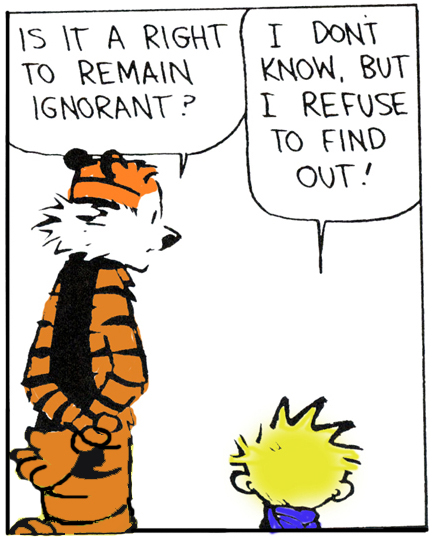
Disrespecting Low-Calorie Light Beer

Ugh, why do people keep defending low-calorie light diet beer? It’s an abomination. It should go away. It’s a marketing trick. It’s the best selling kind of beer in America, and defending it is the equivalent of complaining about the “War on Christmas” or the “War on White People.” Yes, sales have been slipping lately, with more people choosing beer with flavor, but certainly not enough to put much of a dent in the sheer volume of this dreck. Yes, many, if not most, craft beer drinkers choose not to drink it and some even bash it as something not worthy of respect. Well, I am one of those people. Not everything deserves our respect. I respect how difficult it is to make, but in the end that’s not the standard I want to use for how I choose what to drink. Degree of difficulty may be fine for Olympic gymnastics or diving, but taste is far more important to me when it comes to my beer.
So please stop telling me I must love it because it’s really, really hard to make. I get that. I marvel at the technology that must be employed, the sacrifice of ingredients to keep it lighter in color and flavor, the loving care taken to make something that … should … not … exist, and would not exist if not for the Herculean effort to make it. It’s unnatural. So why go to such an effort to make something nobody wanted in the first place? Why spend millions of dollars to convince people they should be drinking it? Why create new processes to create Frankenbrew in the laboratory when ordinary beer was perfectly fine, thank you very much? Anyone, anyone? Bueller? Did anyone say “money?” Show ’em what they win. They win a beer landscape dominated by beer that tastes as close to water as technologically possible. Hooray! Drop the balloons, throw the confetti and start the singing and dancing.
Earlier this summer, David Ryder, Vice-President of Brewing for MillerCoors wrote an op-ed piece in the Chicago Sun-Times entitled In Defense of Light Beer, in which he trotted out the old saws about light beer. The fact that the two top-selling products his company makes are Coors Light and Miller Lite should, of course, have made anyone suspicious of his motives and question any arguments in his editorial piece. The fact that the Sun-Times ran such an obviously biased piece is rather sad, I think. It’s a bit like asking Lee Iacocca to defend the Pinto. You can’t expect objectivity.
But now there’s another article telling me I have to respect light beer, this time in a magazine I actually read, and usually enjoy: Mental Floss. The piece, Scientific Reasons to Respect Light Beer is written by Jed Lipinski, who appears to not be a frequent writer about beer, not that that should matter. After a few anecdotes from craft beer fans disparaging light beer, he launches into his defense:
What few drinkers know, however, is that quality light beers are incredibly difficult to brew. The thin flavor means there’s little to mask defects in the more than 800 chemical compounds within. As Kyler Serfass, manager of the home-brew supply shop Brooklyn Homebrew, told me, “Light beer is a brewer’s beer. It may be bland, but it’s really tough to do.” Belgian monks and master brewers around the world marvel at how macro-breweries like Anheuser-Busch InBev and MillerCoors have perfected the process in hundreds of factories, ensuring that every pour from every brewery tastes exactly the same. Staring at a bottle, it’s staggering to consider the effort that goes into producing each ounce of the straw-colored liquid. But perhaps the most impressive thing about light beer isn’t the time needed or the craftsmanship or even the consistency, but how many lives the beverage has saved.
And there’s degree of difficulty again. Is light beer really a “brewer’s beer?” I have to question that one. But even more of a howler is how “Belgian monks and master brewers around the world marvel at how macro-breweries like Anheuser-Busch InBev and MillerCoors have perfected the process.” They may find the technology or the process interesting, they may even be impressed by the effort, but I think you’d be hard-pressed to find a brewing monk who prefers Bud Light to Duvel, or Orval, or Westmalle. Can anyone really think the average German brewer “marvels” at Miller Lite when compared to the average everyday Bavarian beer? Or that the brewers of England think Coors Light better than the average cask hand-pulled from their local pub? In fact, until the rise of low-calorie diet beer, most Europeans, when referring to “light” beer, thought of light in terms of color, as the German helles (which means “bright” or “light”) or hell (an adjective for “light”). Also, he begins by referring to light beer as having “thin flavors.” Since when has that ever been a positive attribute for anything? When is “less flavor” something to strive for? Name another food product where the goal is to create a version with not as much flavor.
But then there’s that last bit, about how light beer has saved lives. Huh? Yeah, that was my response, too. Huh? And here’s the reason.
“Before it was light beer, it was “small beer.” A popular drink in late-medieval Europe and colonial America, small beer was necessary for certain civilizations to grow. In the days before Brita filters, beer staved off disease and dehydration by packing just enough alcohol to kill off pathogens found in drinking water.
Except that it wasn’t. One didn’t evolve into the other, in some natural progression. The two are not the same, apart from both being low-alcohol and beers. He even contradicts himself by saying that it was popular in medieval times and allowed “civilizations to grow.” Given that civilization was around for thousands of years before that period of history and that beer was there at the very dawn of civilization, I think we can safely say that “small beer” didn’t save mankind. Beer generally had a hand in keeping people healthier longer, allowing those with a tolerance for alcohol to prosper and procreate, but it wasn’t “light beer” that saved the day. If those people had to wait around for brewers to figure out they could use the second runnings of their strong beer to make a lower strength beer that they could sell for less, they would not have survived. Small beer was essentially a way to make more money, to re-use part of the brewing waste, first created by English brewers, although most brewing cultures also made a beer of lower strength that was essentially a table beer. Anchor Brewing has continued the English tradition by making a Small Beer from their Old Foghorn Barleywine Style Ale, and despite it being 3.3% a.b.v., it’s about as far from a low-calorie light diet beer as one could be.
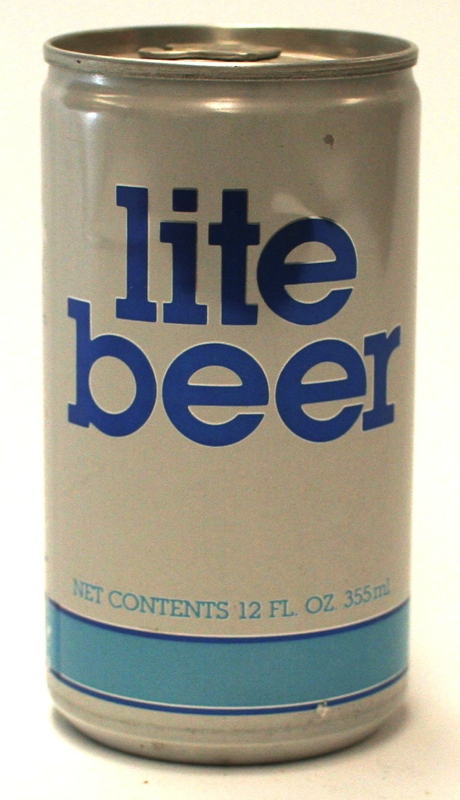
Light beer was the brainchild of one man, who thought people would want diet beer. He was wrong, though he did come up with the process of how to make a low-calorie diet beer. Here’s the story, from an earlier post of mine:
The first low-calorie beer was created by Joe Owades, who, it must be said, had some very strong opinions about beer. He once told me that all ale yeast was dead and inferior to lager yeast. Around 1967, he created Gablinger’s diet beer, the first light beer, while working for Rheingold. It flopped. Big time. Not everybody agrees on what happened next. Some accounts credit Owades with sharing his recipe for light beer with Meister Brau of Chicago while others claim that the Peter Hand Brewing Company (which marketed Meister Brau) came up with it independently on their own. However it happened, Meister Brau Lite proved somewhat more successful than Gablinger’s, primarily due to its superior marketing. Miller Brewing later acquired Meister Brau, and in 1975 debuted Miller Lite, complete with the distinctive, trademark-able spelling.
But it took marketing the new low-calorie beer in a new way so that it removed the “diet” stigma to make it work. They had to trick people into drinking it. Miller’s famously successful “tastes great, less filling” campaign was the primary reason for the category’s success. But it was hardly overnight. It took fifteen years — from 1975 to 1990 — for Miller Lite to reach 10% of the market. Over that time, the other big brewers (loathe to miss out on any market share) introduced their own versions, such as Coors Light and Bud Light, so that whole segment of low-calorie beer was nearly 30% of the beer market by 1990.
Today, seven of the top ten big brands are light beers. Despite its recent dip in sales, it remains a $50 billion segment of the business and still hovers close to half of all beer sold in the United States. That fact, I find to be incredibly sad, frankly. What a great triumph of marketing over common sense and actual taste.
Which is why I hardly think anyone needs to be rushing to its defense. People are willingly drinking it in frighteningly high numbers. I can only assume they’re the same people who buy Wonder Bread, Kraft cheese, TV dinners and every other popular product, even when everybody knows better, healthier, tastier alternatives are available.
Owades supposedly saw the focus group data indicating that people were giving up beer to save calories. Remember, this was the 1950s. Of course, it seems to me the smarter decision would have been to persuade people that beer is not as fattening as they thought. That this is true means it probably would have been a much easier sell. The idea that beer is so fattening is something of a myth, just like the beer belly. It seems to me that if the beer companies at that time had thrown their millions of ad dollars into that message, things might be a lot better today. But they chose the harder path, one we’re all still paying for. Instead of changing the message, they went with “the customer is always right” approach and created a beer to satisfy the consumer’s misconceptions and incorrect assumptions. In other words, when the customer was wrong, they just went with it. When it tanked, instead of cutting their losses, they instead spent millions persuading customers something that wasn’t true; that beer was fattening, but drinking this “magic diet beer” would fix that. The first thing they learned was not to call it “diet beer.” It’s what pharmaceutical companies have learned how to do so well. They first come up with the drug, then create the condition it will cure, even if it didn’t exist before. Anybody remember “restless leg syndrome” before the drug that treats it came on the market?
Lipinski goes on to detail the technology and the steps in the process that big breweries take to create low-calorie diet beer. And even he admits it was a tough sell at the beginning, and how a barrage of advertising was necessary to make it succeed. So tell me again why I have to respect something that had to be sold to the American people through advertising and marketing and which would probably not exist had that advertising failed? If those ads had not worked, low-calorie diet beer could have just as easily ended up on the scrap heap with dry beer, ice beer or tequila-flavored beer.
Peter Kraemer, a VP at ABI, seems to believe part of the problem is with definitions. He claims that “‘light beer’ has lost all meaning over the years” and he “considers [regular Budweiser and Bud Light] both light beers.” In that, he may be on to something. Regular Bud and Bud Light were once judged at GABF as separate categories, but today are sub-categories under the umbrella “American-Style Lager, Light Lager or Premium Lager,” a category I judged a first round of this year. Indeed, even the technical differences in the four sub-categories are slight. I suspect that they may have been more different at one time, but as Anheuser-Busch finally revealed in a 2006 Wall Street Journal article, Budweiser Admits Flavor “Drifted” Over the Years. So regular Bud has been slowly “creeping” closer to Bud Light over the years. But the fact is they taste pretty similar, have not much difference in terms of calories and are separated only in the way they’re marketed. They remind me of the choice between 87 regular octane gasoline and 91 premium octane. I’m told they’re not the same gasoline but damned if it makes any difference to my car, and I’ve long suspected that it’s like an old Dave Berg cartoon I saw in Mad magazine where all the gas actually comes out of one big tank below the pumps, and really is all the same.
And why not, the driving force in these changes is being able to use less ingredients, making the profits higher. It’s not rocket science. Use less malt and hops, and it will cost less to produce the beer, all other costs being equal. Over a small batch or two, it’s probably not that much, but in vats the size of Montana, it makes a big difference to the bottom line. And that’s plenty of incentive to spend the ad dollars to convince people that the flavor you’re not tasting is what you really want, because it’s better for you, won’t fill you up and, besides, it still tastes great. Trust us.
The other reason, or incentive, that the big brewers have for light beer is that having convinced people that they have less calories, people feel that they can actually drink more of them. And that’s what they end up doing. So by promoting them as healthier, diet beer, people end up actually drinking more calories. As The Litigation Consulting Report explains, in order to get the same buzz, that is the same amount of alcohol (which is also lower in most light beers), you’d have to drink 15 light beers to get the same alcohol that’s in six regular beers. According to them, this is known as the “compensation” effect and “is an issue in some product liability cases.”
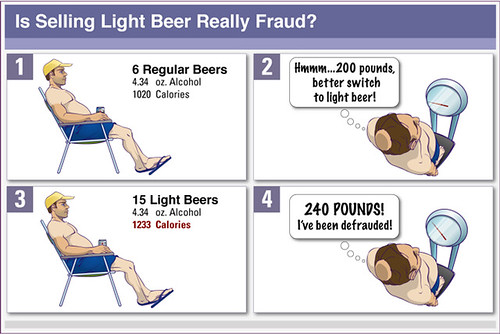
But the diet aspects of beer already work for all beer, no reason to even sacrifice the flavor between the two. But since they’re admittedly both the same, you may as well avoid both regular and the diet versions in favor of something with actual flavor. That’s one of the biggest reasons I hate low-calorie diet beer: there’s simply no reason for it to exist. For most beers, have two instead of three and you’ll be ahead of the game. Drink smarter, drink better.
I realize I’m in the minority here, as every time I write about counting calories, people comment that they do actually watch their caloric intake, but I do not, and never have. I’ve gone over 50 years without counting a single calorie and, while I may not be the world’s healthiest man, I’m not the world’s worst either. And I’ve certainly never regretted choosing to eat or drink whatever I want. I find the slavish obsession to calorie counting absurd, but have come to recognize that many people really do care about them. I’ve written about this issue before, in Calories In Beer: Can We Please Stop?, Calories In Beer: Can We Please Stop, Part 2 and Read This, Not That. Life is undoubtedly about making choices, assessing risks and deciding what’s best for you.
Still, if you love beer, why defend low-calorie diet beer that is in every way as far from actual beer as possible? Everyone acknowledges it has less flavor. It has a few less calories, but stripping calories also strips … wait for it … flavor. But the difference between regular and diet beer seems so slight to me to be almost meaningless, especially when simply drinking one less beer would have roughly the same effect. If Budweiser has 145 calories in a 12 oz. bottle, and Bud Light has 110, drinking three diet beers would save you 105 calories. But have just two Buds, and you’d save 40 calories over three Bud Lights. Better still, choose two Samuel Adams Boston Lagers (160 calories) and you’d still save 10 calories over three Bud Lights or choose two Sierra Nevada Pale Ales (175 calories) and it will cost you only 20 more calories than drinking three Bud Lights would, though you’d still save 85 calories drinking two Sierra Nevada Pale Ales instead of three regular Budweisers. The point is that the caloric savings in diet beers are a sham. The differences are too slight to sacrifice so much flavor and enjoyment.
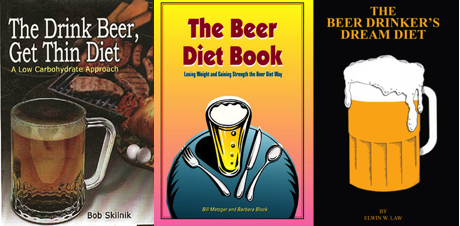
To sum up, diet beers were created in a laboratory to fill a need that didn’t exist. Making the beer that nobody wanted is incredibly difficult, and much harder than just making normal beer. To be successful, millions of dollars had to be spent on marketing and advertising to convince people to buy the thing that’s harder to make that they didn’t want in the first place. Finally, after nearly 40 years, and at least 20 that they’ve dominated the market, sales are starting to slip as people are choosing beer with more flavor instead. But rather than follow the shifting marketplace, pleas are being made that we should respect the beer nobody wanted that’s harder to make because … well, just because it is so danged hard to make and is a technological marvel deserving our respect.
As Lipinski wittily remarks in his closing sentence, he hopes his efforts at persuading you to respect light beer will “help you see the brew in a new light,” but there’s really nothing new in his arguments. His “scientific reasons” can only command your respect up to a point. I can respect the process, I can respect the technology, I can respect the effort made, but I still can’t respect the results. I honestly don’t understand how anyone can, quite frankly. With no disrespect to the many wonderful brewers who make low-calorie light diet beer, you can do better. You know you can. I have no truck with your skill as brewers or with the technology you wield so impressively. But I want a beer with more flavor. So until diet beer, like so many other diet products, tastes exactly the same as the more flavorful beers I prefer, I can’t give it the respect you insist it deserves.
Beer Bouncing Back
![]()
Nielsen, the company that tracks all things trackable, is speculating on their NelsonWire that beer is bouncing back and that this may signal the “beginning of a beer boom.” According to their data, “Beer sales are seeing a surge in growth, up 5 million cases (1.4 percent) in the last 12 weeks through September 1, 2012, in Nielsen-measured retail outlets. The same period last year saw a decline of 1.7 million cases.”
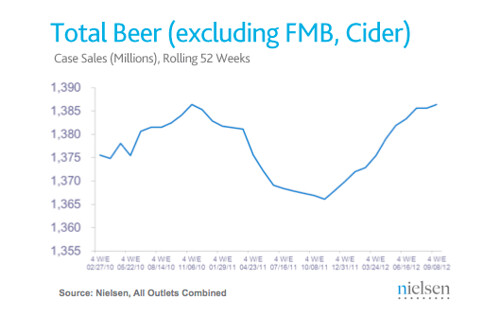
The main reason they cite for this is choice.
With more options on shelves and innovative product offerings, new consumers were attracted to the beer category. Nearly half of the households who were new to malt, or cider-based beverages (beer, flavored malt beverages and cider) in the past six months had bridged over from solely buying wine or spirits last year.
But as they’re focused to a greater extent on the bigger players in the category, they mean choice in a different way than you and I normally understand it. When Nielsen refers to choice, they mean “flavors, formats and packaging,” though in my experience it’s always “packaging options” that seem to get the most attention. But even with the term as common as flavor, it’s used here as more jargon instead of what you’d ordinarily think it means. By “new flavors,” they don’t mean more different styles or kinds of beer on the average beer set shelf. No, they mean line extensions like the two they give as examples: “Bacon Maple and Blue Raspberry Lemonade,” as a part of other already-established brands.
So while this is good news, and we should all welcome a coming “beer boom,” I can’t help but wonder if this “boom” of which they speak — which quite frankly the craft beer side has been seeing for a decade — is not going to favor them as much as the regional breweries and even the smaller craft breweries. That’s what it’s been doing for several years now, and I can’t see any reason to suspect that will change in the coming months or years, no matter how “bright the last quarter of 2012 may be for beer.” Still, a coming “beer boom” sure has a nice ring to it.
The Daily’s Foolproof Guide To Picking The Perfect Brew

With tongue firmly in cheek, The Daily posted this chart on Sunday, calling it their Foolproof Guide To Picking The Perfect Brew.
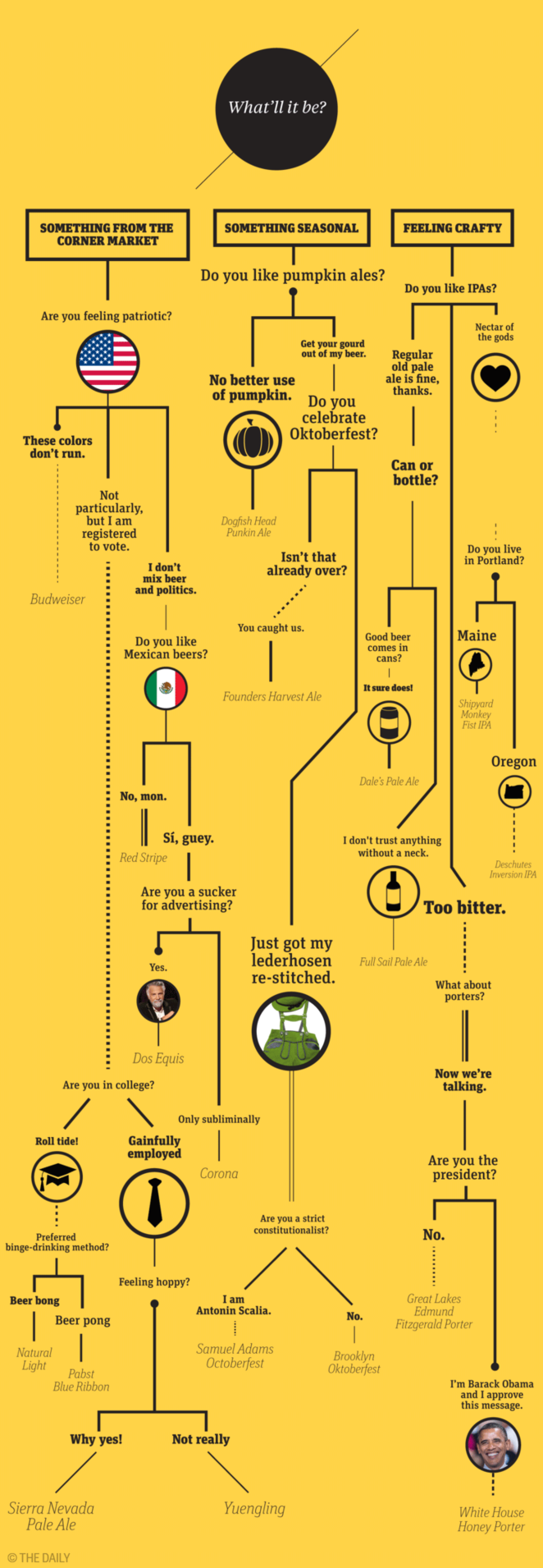
Why Is This News? Beer Beats Wine!

I never quite understand why this is even considered news at all? The L.A. Times is reporting that “Beer beats out wine as Americans’ booze of choice.” Their source for this so-called news is a new Gallup Poll entitled Majority in U.S. Drink Alcohol, Averaging Four Drinks a Week. But that’s not exactly news insofar as it’s been that way since the dawn of time, or thereabouts. The gallup poll is just a survey, of course, and prone to people’s prejudices and perceptions. So when they report that “Beer edges out wine by 39% to 35% as drinkers’ beverage of choice,” it’s hard not to laugh, and even harder to take it seriously. This is what people tell pollsters, and it’s pretty divorced from reality.
If you want a truer, more accurate picture of peoples’ tastes, look at what they buy. The World Health Organization, at their website, gives the following data, collected in 2005 (though it rarely changes by much):
Alcohol Consumption By Type:
- Beer: 53%
- Wine: 16%
- Spirits: 31%
And the Ginley USDC 2010 reports that for 2009, the volume of alcohol sold in the U.S. — 3.3 billion cases — is divided as follows, giving beer an 85 share:
Alcohol Sales By Volume:
- Beer: 85%
- Wine: 6%
- Spirits: 9%
And by retail dollars — a total $1.89 billion — beer still has a commanding lead:
Alcohol Sales By Dollars:
- Beer: 52%
- Wine: 14%
- Spirits: 34%
It doesn’t really matter what people tell the voice on the other end of the phone when Gallup calls asking for peoples’ preferences, this is what they really drink. And while it does fluctuate over time, it’s been roughly like this as long as anybody can remember. Trying to turn it into something newsworthy takes a certain amount of opportunistic forgetfulness, ignorance and a willingness to ignore history.
And while somewhat petty, this also struck me in a way I couldn’t ignore, like someone slapped me. The author of the L.A. Times piece, Tiffany Hsu, refers to men as floozies, when she reports. “Men tend to be the biggest floozies, downing 6.2 drinks a week on average compared with 2.2 drinks for women.” Now I assume she owns a dictionary, and I was pretty sure what the definition of a floozy was. So after checking at least six dictionaries to confirm my suspicions — like it or not — a floozy is always described as a woman. It’s an old, archaic word you rarely hear these days, but it doesn’t mean someone who drinks too much, as she appears to believe.
There’s also other findings in the Gallup Poll results, part of their annual Consumption Habits poll, and some are interesting, if not altogether showing anything particularly novel or new. But toward the end of Gallup’s press release, they make this obnoxious statement in the conclusion, which they title “The Bottom Line.”
With drinking comes overdrinking, and despite possible reluctance by some respondents to admit problems, one in five drinkers — representing 14% of all U.S. adults — say they sometimes drink too much.
Okay, first of all, WTF! “With drinking comes overdrinking?” No it doesn’t. It’s hardly a fait accompli. Even by their own numbers, that’s twisted logic. 86% of the people polled say they don’t drink too much so one clearly does not follow from the other, now does it? And how about this for twisting; “one in five” is 20%, not even close to 14%. You can’t even say that’s rounding, it’s simply inflating the numbers. So much for even the illusion of accuracy.
And just the idea that one alcoholic beverage has “beat” the other is annoying, too. I may prefer beer, but as a cross-drinker — like most people, frankly — I don’t feel that they’re competing in an us vs. them kind of way. It seems only news outlets hungry for headlines pit the two against one another. The first sentence of the article is “Score one for beer.” What was the contest?
There are plenty of positive stories from the world of beer that mainstream media could be covering. As Garrett Oliver recently wrote in Food & Wine magazine, one of the Crimes Against Beer is its continuing lack of media coverage. Oliver writes. “The public is yearning for more knowledge about beer, and nobody’s giving it to them. Even though craft beer is more popular than wine in the US, every major newspaper has a wine column, and almost nobody has a beer column. What’s wrong with this picture?”
What’s wrong, indeed.
UPDATE: An interesting side discussion came out of my linking Garrett Oliver’s piece, Crimes Against Beer, in which he casually mentions that “craft beer is more popular than wine in the US.” I confess that when I first read that, I thought it couldn’t be correct, but since it wasn’t relevant to the broader point I was trying to make in this post, I didn’t dwell on it. Alan, from A Good Beer Blog, however, did, and used it as a launching point for his own post, Is All That Made Up Stuff A Problem With The Dialogue?. He also did a little digging this morning to get at the actual numbers, and between the two of us, here’s what we found. Alan looked at statistics gathered by the Brewers Association and the Wine Institute. He found that in 2011, there were 347 million cases of wine and 11,468,152 barrels of craft beer sold in the U.S. From that he concluded that craft beer volume is roughly one-third of wine. Being lazier than Alan, I looked at retail dollars from the same sources and saw that there was an “estimated $8.7 billion” in craft beer sales and $32.5 billion in U.S. wine sales. That works out to craft beer selling about 26.8% — just over one-quarter — of wine sales. So no matter how you slice it, craft beer sales are nowhere near that of wine sold in America. That number could be slightly higher, as my one quibble with this is that the Brewers Association definition of what it means to be a craft beer is fine for their purposes (which is membership-based) but is not practical in the real world where what makes a beer crafty is, to my mind at least, how it’s made and how it tastes. I do, for example, consider Blue Moon a craft beer. And that would change the numbers to some degree, but I suspect not enough to alter the fact that wine still outsells craft beer, at least for now.
Travel Channel Picks The “Top 7 Beer Destinations”

Okay, these things are pretty easy to pick apart because no one will ever agree on where the “best” or “top” destinations are for anything, beer or otherwise. I understand that top x lists are very popular. Hell, I enjoy making them myself. They can be fun. But take a look at what the Travel Channel, written by NYC-based travel writer Jimmy Im, has chosen as the Top 7 Beer Destinations.
- Asheville, North Carolina
- Los Angeles’ Popular Breweries
- Virginia’s Lagers and Ales
- Toronto’s Craft Breweries
- Finger Lakes, New York’s Beer Hub
- Atlanta’s New Brews
- Traverse City, Emerging Beer Town
So while I’m sure none of the places he’s listed are bad beer destinations, and certainly a few of them deserve to be on this list, I have a hard time accepting these as the very top destinations. The list strikes me as being from someone who’s not really connected to the beer community in any meaningful way. If they had only resisted calling them the top beer destinations and called them instead something like “seven beer destinations worth visiting” that might have worked, but they didn’t. Im specifically states that “these destinations that are fast becoming beer scene kings that offer some of the best suds in town.”
So while I have no problem with Asheville being here, ignoring Philly, Portland (both Oregon and Maine), San Francisco, San Diego, Seattle, Denver, Boston, Chicago and several others makes this list more infamous for what it’s left out than what was chosen. Certainly L.A. is an up and coming beer city, and has made great strides over the last few years, but I’m not sure I’d put it as the second-best beer destination, especially over so many others left out. And he singles out the Strand Brewing Co. and El Segundo Brewing Company as “two of the more popular breweries.” No disrespect to those two breweries — I haven’t been to either of them but I’m sure they’re fine places — but those are not the L.A breweries that are making a splash lately.
Third is the entire state of Virginia, and Im seems to have chosen the Old Dominion State because it’s “so obsessed with its beer culture, it is officially naming the month of August ‘Virginia Craft Brew Month'” and now has 40 breweries. Well July is Oregon Beer Month and February is California Beer Month. Oregon has over 160 breweries and California around 325. So while Virginia is a terrific state and undoubtedly has some fine breweries, if obsession, state beer months and the number of breweries is his criteria, then I’m just not sure Virginia is the right one to choose.
The remaning four, Toronto, the New York Finger Lakes, Atlanta and Traverse City, Michigan, again I’m sure are all fine beer places, but do they deserve to be among the “top 7?” By choosing Toronto, he’s also opened the door to other international beer destinations, of which there are numerous examples, many of which most people would choose over some of the destinations on the Travel Channel’s list. With the last one, Traverse City, Im seems even to have forgotten his own mandate, when he refers to the Michigan town as an “emerging beer town.” It may well be, but shouldn’t we wait until it’s emerged before putting it on the list of the top spots?
So while these things are, as I alluded to, very subjective and depend greatly on how you define the criteria used to rank them, these choices wouldn’t pass muster for even a casual beer lover. It could have been a fun list if they’d only resisted the temptation to declare them the “Top 7 Beer Destinations.” They’re just not.
What We Spend On Alcohol

NPR’s Planet Money blog had an interesting report today entitled What America Spends On Booze, breaking it down with some recent data from the U.S. Bureau of Labor Statistics and some great infographics by Lam Thuy Vo of NPR.
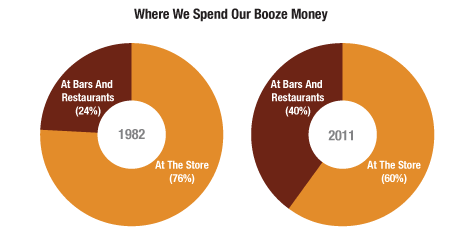
As you can see, we drink outside our homes almost twice as much as we did three decades ago, though as Lam Thuy Vo notes, that’s a little deceptive at least partly because the price of alcohol in bars and restaurants has skyrocketed while real prices have fallen, when adjusted for inflation.
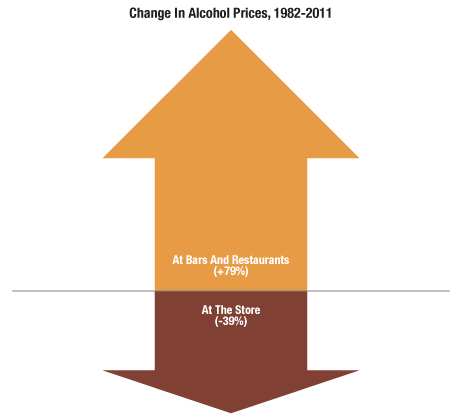
Also, what we spend our alcohol dollars on has likewise shifted over the last thirty years. While beer is still on top, it has slipped a little. Wine is way up, while spirits have significantly dropped.
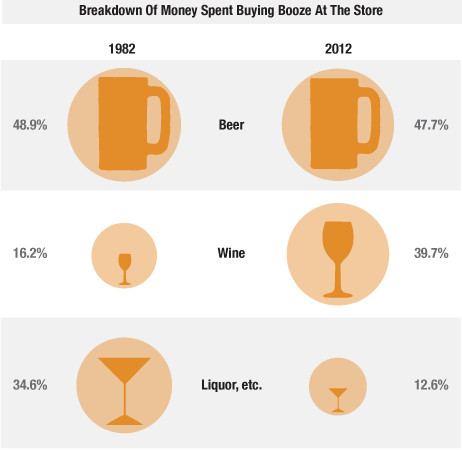
The one thing I’m a bit surprised about is the drop in beer. Since the price of craft beer is generally higher than mainstream adjunct lagers, I would think that the higher dollar rings would cause the figures for beer to rise as the percentage of craft beer has increased. Perhaps the price wars among the big players that have kept the price of beer artificially low for so long have contributed, or at least partially account, for the extended dip.
Betty Crocker Beer?

Who knew that Betty Crocker even knew about beer? Today, I saw that they posted 35 Beer Terms Every Beer Lover Needs To Know, and it’s not a bad list. Of course, it helps that it was compiled by a Cicerone — Michael Agnew. But beyond that, there’s a whole section on Betty Crocker’s website dedicated to beer entitled Betty’s BrewHouse. Way to stay hip and with it, Betty. I guess she’s not just about cakes and brownies anymore.
Anatomy Of A Propaganda Piece

With Alcohol Justice promoting it, I just knew there had to be more to the CNN story Movies May Increase Binge Drinking in Teens. The article is based on a study published in the journal Pediatrics with the more benign title Alcohol Consumption in Movies and Adolescent Binge Drinking in 6 European Countries. But either way, Hollywood is, of course, the bogeyman. The study “surveyed 16,500 students ages 10 to 19 from Germany, Iceland, Italy, the Netherlands, Poland and Scotland.”
The students were asked how often they drank five alcoholic beverages during one sitting [interesting a European study has adopted the ridiculous U.S. definition of “binge drinking”], and about the types of movies they watched. Participants were given a list of 50 movies to choose from, which included many top box-office hits from the U.S. The number of drinking scenes was tallied for each movie.
I don’t have the resources to pay to see the whole study, so I don’t know what films are on the list, but the first thing I have to wonder is how many of those films are age-appropriate for 10-year olds? Many Hollywood blockbusters would be at least “PG-13” (so no 10-12 year olds allowed) or “R” (no 10-17 year olds allowed). Are there many movies with “drinking scenes” that are “G” or that every parent would find appropriate for their 10 through 19 year old child? There’s also no breakdown of how many kids were 10, 15, 19, etc., but I have to believe there’s a vast difference between the effect of watching a film on a ten-year old and a young adult, age 18 or 19. The researchers apparently also considered other so-called “risk factors,” and somehow accounted for each “teen’s levels of rebelliousness or sensation-seeking, peer drinking levels, family drinking patterns, affluence and gender.” That’s a lot of data on 16,500 kids, and almost none of it could be considered the “hard facts” type.
The overall results were that “27% of the sample had consumed >5 drinks on at least 1 occasion in their life.” So roughly 1 out of 4 of the “kids” had consumed 5 drinks at least once, and possibly ONLY once, in their life. And of those 16,500, some of the “kids” were legally allowed to drink 5 beers if they wanted to. In Germany, Italy and the Netherlands, the minimum age for drinking is 16. In Poland and Scotland it’s 18 (though once source I have says it’s 16 in Poland). In Iceland it’s 20. So for at least half the countries where the kids were surveyed, they were permitted to drink at least beer 4 out of the 10 ages of “kids” in the study.
For five-sixths of the countries, at least some of the ages of children surveyed were likewise legally allowed to drink alcohol. Like the age breakdowns, there’s no information available (at least to me) about how many of those surveyed were from which country. Given all the supposed control factors they accounted for, the legal age at which people in the surveyed countries are permitted to drink alcohol seems nakedly absent and, at least to my way of thinking, a rather important omission.
And one last comment about their methodology, such as it was. To determine each film’s — I don’t know, “quotient,” “unworthiness” or whatever — “the number of drinking scenes was tallied for each movie” by the researchers. But is the sheer number of times there’s a scene of people drinking in any way relevant? Is there no context to each scene? Are there not positive and negative ways to portray drinking alcohol? I already know the answer to that one, as obviously the researchers are convinced that ANY depiction of people drinking alcohol they consider wrong, but of course a second’s thought will reveal that to be patently nonsense. Just counting how often people are seen drinking alcohol in a film really tells you nothing about how influential it will be, or indeed, if it registers anything at all. Shown being consumed responsibly, it could just as easily be a positive influence.
Personally, I’m much more concerned about my kids seeing casual violence in films than drinking. But there, as well as in America, research continues to claim that there’s a direct “link between drinking in movies and adolescent alcohol consumption habits.” This latest study’s conclusion likewise claims that the “link between alcohol use in movies and adolescent binge drinking was robust and seems relatively unaffected by cultural contexts.”
But in the last paragraphs — well after most people probably stopped reading — was what I’d been thinking as I read this, that “even though the European study shows a strong association between what is seen on the movie screen and binge drinking, it cannot show cause and effect.” Like Otto Preminger’s Anatomy of a Murder, not everything is as it seems.
And despite the tone of the story up until that point having been confidently certain, as expressed in the headline’s more movies, more binging (or better mo movies, mo binging), it may not be as certain as they would have you believe. Here’s the smoking gun.
It may be that binge drinking teens seek out movies that have alcohol scenes, or it could be that seeing scenes of alcohol use in movies makes them more likely to binge drink. More research is needed to confirm these findings.
I continue to be troubled by the wide range of ages surveyed, because in my experience those are the ages when people change more in a shorter period of time than at any other time in their entire life. The conclusion suggests that to combat this scourge, parents should “go to the movies with [their kids] and discuss what you’re seeing. What you say matters more than what one TV show or one movie says.” In other words, be a parent. So is this a problem of parenting or the movies? Should movies be stripped of adult content because kids might watch them? That does seem to be a common strategy by neo-prohibitionist groups, especially with regard to advertising.
In the end, this seems like yet another study riddled with more questions than answers. But, as is typical, those questions — if the media raises them at all — are buried at the end of the article, well after the average person has given up reading and has moved on to something else. What we’re left with is a “survey” (and we all now how teenagers always tell the truth about what they’re doing) of kids in six varied nations (with different minimum drinking ages) who are of widely different ages (from a childlike ten to a young adult 19) who appear to binge drink more (or at least once) if they see Hollywood blockbuster movies (or it may be teens who drink prefer those movies). Tell me again how exactly that’s news?
